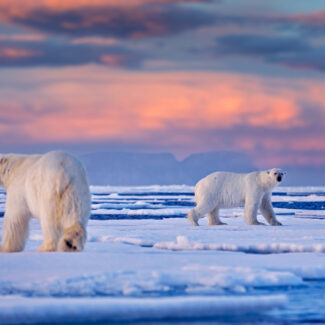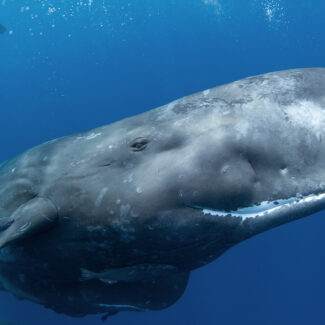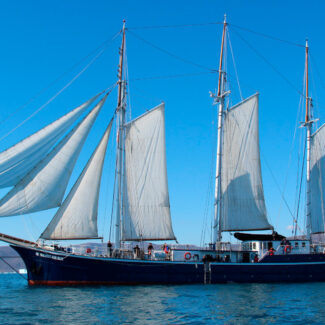Top 10 Most Dangerous Animals In Antarctica
Let’s be clear: The odds of being attacked by an animal on a typical tourist visit to Antarctica are vanishingly small, unless perhaps you count defensive dive-bombs from a seabird whose nest you’ve strayed too close to. The White Continent doesn’t harbor dangerous terrestrial wildlife, and most people are unlikely to directly share waters with the few marine species that could conceivably pose a risk.
So consider the following roundup of the top 10 most dangerous animals in Antarctica as, really, more a profile of some of its most impressive predators, each and every one performing an essential role in the marine and coastal ecosystems at the bottom of the world. Most of the following critters haven’t even been implicated in attacks on people, though all warrant plenty of respect.
1. Leopard Seal
Going off statistics and reputation, the leopard seal is probably the most notorious Antarctic predator, though even this pugnacious pinniped only rarely behaves aggressively toward people. Given its imposing size, power, and opportunistic predatory style, though, it’s definitely a creature to avoid close encounters with.
Named for the spotting on their pale hides, leopard seals look rather more reptilian than mammalian, what with their elongated bodies and massive, toothy jaws. They rank among the biggest of the Southern Ocean’s pinnipeds, commonly growing to nine or 10 feet and 700 to 900 pounds; females, which are heftier than males, occasionally exceed 11 feet and weigh more than a half-ton.
Inhabiting the Antarctic pack-ice and also straying well north to sub-Antarctic islands as well as South American, South African, New Zealand, and Australian waters, leopard seals are top predators of the Southern Ocean. While young seals feed heavily on krill, full-grown individuals readily target such warm-blooded prey as penguins and pups and smaller adults of other pinniped species such as Weddell, crabeater, and Antarctic fur seals. Adult leopard seals will also munch fish, squid, and krill. The rather terrifying dentition of the leopard seal reflects this wide-ranging diet: The distinctive, three-pointed, interlocking molars allow them to strain krill from the water, while the enormous canines are employed to seize larger prey.
Their streamlined, serpent-like profile makes leopard seals impressively speedy and agile underwater, capable of chasing down fleet penguins (which they also ambush along the edges of ice floes). The sight of a leopard seal thrashing a doomed Adelie or gentoo penguin around, rending the creature apart, is among the gorier—and more indelible—of Antarctic spectacles.
Leopard seals have been implicated in a handful of attacks on human beings, though emphasis on handful. There’s been one documented fatality: In 2003, a leopard seal killed a 28-year-old marine biologist with the British Antarctic Survey (BAS) who was snorkeling off the Rothera Research Station on the Antarctic Peninsula. While that was an unprecedented incident, scientists doing coastal or underwater work in Antarctica are plenty wary of leopard seals: BAS policy, for example, is to avoid getting in the water if the animals are present, and to exit the water promptly if one appears.
The average sightseer in Antarctica isn’t getting into the water, which keeps them from most of the danger posed by a leopard seal. That said, visitors afoot along the coast should definitely give any hauled-out leopard seals oodles of room.
Don’t let the seemingly relaxed pose fool you; the leopard seal is one of Antarctica’s most formidable predators. With a powerful jaw and formidable teeth, this marine hunter is a true force of nature in the icy waters, reminding us of the raw, untamed power of the continent’s most dangerous animals.
2. Orca
It’s conceivable leopard seals in the far northern fringe of their range might occasionally fall prey to great white or tiger sharks. But in Antarctica, this formidable pinniped fears only one (non-human) predator: the orca, aka killer whale, making them arguably the most deadly animal in Antarctica.
Actually, the degree to which Antarctic orcas prey on leopard seals isn’t really known, though a few instances have been documented. Orcas are the top dogs of the World Ocean’s top dogs, combining great size—big males, or bulls, may reach 30 feet or so and weigh 10 tons—with highly sophisticated cooperative hunting techniques. Teamwork allows them to hunt baleen whales—even, at least occasionally, the biggest of all animals, the blue whale.
In fact, orcas display a great diversity of dietary preferences, and populations targeting specific prey often show distinct morphological characteristics as well. Thus, biologists have begun classifying orcas in many parts of the world—Antarctica very much included—into separate ecotypes, which some believe may actually represent entirely separate species.
In Antarctica, Type A (or Antarctic) orcas—on average the biggest of the region’s killer whales, exhibiting a “typical” body plan shared with orcas in many other parts of the globe—seem to have a taste for southern minke whales. Type B killer whales, commonly observed off the Antarctic Peninsula, have been split into Type B1, or pack-ice, orcas, which mainly hunt seals, and Type B2, or Gerlache, orcas, known to prey on both penguins and Weddell seals. The comparatively small Type C, or Ross Sea, orca appears to be a fish-eater, perhaps specializing in the large Antarctic toothfish. (Scientists have also tentatively identified a mysterious, fish-eating Type D orca, but this ecotype is of sub-Antarctic distribution, not yet documented south of 60 degrees latitude.)
Like their compatriots elsewhere, Antarctic orcas boast an impressively diverse toolkit of social hunting tactics. For example, Type B orcas will spyhop—extending their heads above the surface of the water—to eyeball seals hauled out on ice floes, then generate waves to maneuver, break apart, and/or overwash the floe, knocking the unfortunate seal into the water.
Despite their awesome predatory prowess, orcas have never been implicated in a fatal attack on a human being in the wild, and the very few interactions tentatively identified as attacks commonly seem to suggest a case of killer whales mistaking a person for more typical prey. (Captive orcas have occasionally injured and killed people, but not much regarding wild killer whales can be extrapolated from such behavior.) For whatever reason—and let’s be grateful—orcas don’t seem to perceive people as food. Nonetheless, kayakers and other boaters in small crafts—as the Japanese crew of the petite polar vessel Kainan-maru might have told you after their frightening encounter with a school of 20 killer whales back in 1912 near King Edward VII land—should exercise caution around orca pods.

With their striking black and white markings and powerful hunting strategies, orcas are the apex predators of the Antarctic waters. These intelligent and cooperative hunters, often seen patrolling the icy straits, underscore why they are considered one of the most dangerous animals in Antarctica’s remarkable ecosystem
3. Southern Sleeper Shark
Not much is known about the southern sleeper shark, one of several huge dogfishes—sharks of the taxonomic order Squaliformes—known from high latitudes (and, recent discoveries suggest, deep-sea environments of lower latitudes, too). The southern sleeper has been recorded in many parts of the Southern Ocean, including sub-Antarctic waters; whether it extends into the true Antarctic is, like so much else about this deepwater predator, not exactly clear, though the International Union for the Conservation of Nature (IUCN) lists Antarctica as part of its probable range.
Like its Northern Hemisphere relatives, the Greenland and Pacific sleeper sharks, the southern sleeper grows to a large size: at least 14 feet, perhaps 20 feet or even longer. Stomach analyses of captured specimens suggest it preys on cephalopods—including the very large giant and colossal squids—as well as fish and marine mammals. A southern sleeper shark obtained off Chile had swallowed a southern right whale dolphin outright. The huge sleeper sharks of both the Northern and Southern Hemisphere, while apparently normally sluggish swimmers, seem capable of bursts of speed to ambush pinnipeds and small cetaceans.
Needless to say, you don’t need to worry about getting ambushed by a southern sleeper shark in Antarctica. But it’s thrilling to consider the presence of this supersized dogfish at least on the outskirts of the Antarctic zone.
4. Southern Elephant Seal
Antarctica serves as prime foraging ground for what is, by a fair measure, the largest of all pinnipeds (and the biggest non-cetacean marine mammal): the southern elephant seal. Bulls of this magnificent beast, which far outsize females, may reach lengths of 20 feet and weigh more than three tons. This makes the southern elephant seal the biggest of all members of the mammalian order Carnivora, some measure larger than the largest terrestrial carnivores (brown and polar bears). A full-grown dominant bull, besting rivals in often-bloody battles to control shoreline breeding turf, well deserves the title of “beachmaster.”
But such breeding takes place away from the White Continent, on sub-Antarctic islands as well as Argentine Patagonia’s Valdes Peninsula. Those locales are also where southern elephant seals haul ashore to molt. Outside of those seasons, the seals journey to Antarctic waters to feed: the bulls mainly over the Antarctic continental shelf, the cows typically farther out to sea.
What are southern elephant seals feeding on here? Namely deepwater fish and squid, which they pursue on spectacularly deep dives that rank among the most impressive pulled off by marine mammals. They commonly dive down several thousand feet, and have been recorded going past a mile under the surface. This ability is facilitated by this huge seal’s voluminous blood supply and its notably elevated concentration of red blood cells, which supply oxygen to the body.
You wouldn’t want to test the personal space of a southern elephant seal, male or female, but this species isn’t out to otherwise attack human beings. No question, however, that this is one of Antarctica’s truly superlative denizens.
While not predators in the typical sense, a full-grown Southern Elephant Seal can be incredibly dangerous due to its immense size and territorial nature. Especially during breeding season, these colossal animals can exhibit aggressive behavior, making them a formidable presence in the Antarctic landscape and a creature to be respectfully observed from a distance.
5. Sperm Whale
Mature male sperm whales feed in Antarctic waters, unlike females, which predominantly inhabit tropical and subtropical zones. Sperm-whale bulls in both the Northern and Southern hemispheres migrate between the tropics and polar latitudes, and in Antarctica they’re mainly found during the austral summer and fall months, as they appear to prefer hunting in ice-free areas or along the edge of pack ice.
Sperm whales are the biggest of all toothed predators: Bulls may approach 70 feet in length (and may have grown even bigger in the past, before industrial whaling). In Antarctica, bulls feed primarily on squid, in particular the large colossal and giant squid, though they’ll also take Antarctic toothfish. As with the southern elephant seal, such prey is sought on epic dives.
As with essentially all of the animals on this list, sperm whales don’t go out of their way to attack human beings—a very good thing indeed, given their size and that tooth-studded lower jaw of theirs—and assaults on boats by this superb leviathan mainly derive from the whaling era. Pound for pound, though, there’s no grander predator to grace Antarctic depths than this.
The immense size and predatory prowess of the Sperm Whale, renowned for its deep dives and hunting of giant squid, solidify its place among the most formidable creatures in the ocean. While rarely encountered, its sheer power and presence mark it as a potentially dangerous, albeit awe-inspiring, giant of the Antarctic waters.
6. Colossal Squid
We’ve already mentioned the colossal squid as a prey item: of the southern sleeper shark and the sperm whale, notably, though smaller individuals might also be taken by elephant seals. But that’s not to diminish the magnificence of this organism, heftiest of the cephalopods and indeed of all invertebrates.
Bulkier than its better-known relative the giant squid, the maximum size of the colossal squid is not exactly established, though it surely can exceed 30 feet in length and 1,000 pounds in weight. Given the paucity of actual specimens ever captured, estimates of the colossal squid’s heft largely come from the squid beaks recovered from sperm-whale stomachs.
Vulnerable as they are to sharks and whales, full-grown colossal squid are imposing predators in their own right, combining that great size with the crushing beak and arms and tentacles that come barbed with hooks. They likely feed predominantly on fish (including the Antarctic toothfish) as well as smaller squid and other marine invertebrates down in the dark depths.
It’s easy to envision dramatic kraken-esque exploits when pondering the size of the colossal squid, but in truth this biggest of cephalopods poses no risk to human beings. That said, how could we leave it off a list of Antarctica’s most awe-inspiring predators?
7. Southern Giant Petrel
In truth, the southern giant petrel doesn’t pose much of a risk to human beings, though it must be said that if one wanted to, it could do some real damage to a person. After all, this is among the biggest and most formidable of all seabirds: sometimes exceeding 10 pounds, spreading wings more than six feet from tip to tip, and possessed of a massive hooked bill.
The southern giant petrel, which breeds in places on mainland Antarctica as well as sub-Antarctic islands and the lower reaches of the southern continents, employs that big beak to take prey ranging from fish and squid to other seabirds (including penguins) as well as vulnerable pinniped pups. It’s a testy bruiser of a bird indeed.
8. Antarctic Fur Seal
A number of fur-seal species inhabit the Southern Ocean, the most southerly of all being the Antarctic fur seal. Most abundant in sub-Antarctic reaches, in fact, this good-sized pinniped may exceed 300 pounds. They would only be considered dangerous in the case of a person coming too close, in which case their bulk, sharp canines, and potentially aggressive mode of defense would likely be intimidating to behold.
9. South Polar Skua
Smaller as it is than the giant petrel, the south polar skua is a spunky seabird notorious for punishing people (and any other animals) that come too near its nest—hence its inclusion on this lineup. It’s also one of the great feathered pirates, obtaining much of its food by robbing the catches of other seabirds.
10. Human Beings
What is the most dangerous animal in Antarctica? Surely the answer must be—well, Homo sapiens, ourselves. One could make the argument we’re the most volatile, unpredictable, and aggressive of large creatures, and certainly when you consider the relative lethal impact of our kind upon other beings and vice versa, it’s clear that humans are the most formidable of all predators.
That ends our list on a message of conservation: We ought to celebrate the fact that people nowadays predominantly come to Antarctica as either researchers or tourists keen on seeing wildlife. It’s also a note of reassurance: You don’t need to fear the potentially dangerous animals of Antarctica, so long as you give them the physical space—and the all-around respect—they deserve!
Disclaimer
Our travel guides are for informational purposes only. While we aim to provide accurate and up-to-date information, Antarctica Cruises makes no representations as to the accuracy or completeness of any information in our guides or found by following any link on this site.
Antarctica Cruises cannot and will not accept responsibility for any omissions or inaccuracies, or for any consequences arising therefrom, including any losses, injuries, or damages resulting from the display or use of this information.










